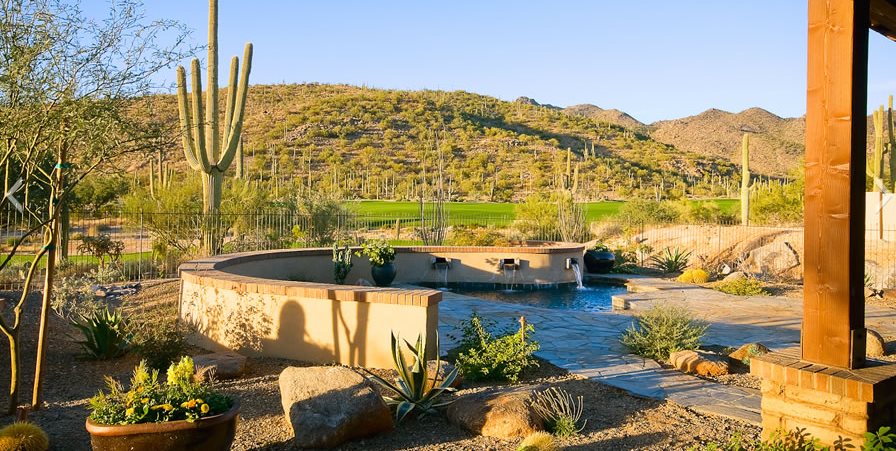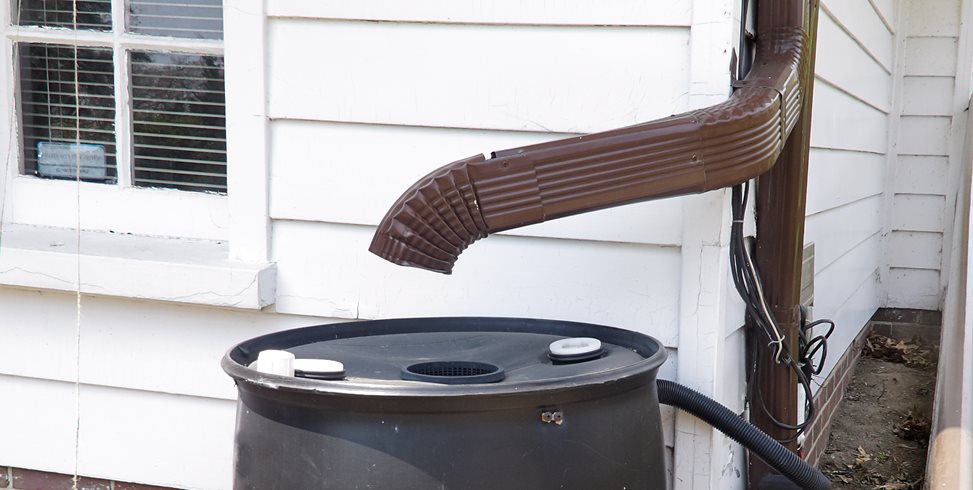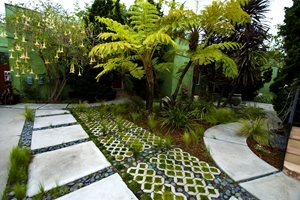Rainwater Harvesting and Collection
Compare different methods of rainwater harvesting & get tips for successWith water shortages hitting many parts of the country, rainwater catchment systems are becoming an appealing option. By catching winter's bounty of water and saving it until the dry heat of summer, you can reduce your dependence on the city water supply and lower your water bill. The downside is the tanks can be expensive to install, and finding the storage space for certain setups can be a challenge. Here, professional landscapers share their tips for success.
Methods of rainwater harvesting
Bioswales.
By carefully grading a subtle channel throughout your landscape, you can direct the flow of water to a rain garden or drain. As the water runs through the landscape, it's filtered by plant roots and soil to remove toxins, such as from an asphalt-shingled roof. With a bioswale, the water is directed through the landscape, but may not always be reused.
Rain gardens.
A rain garden takes advantage of a damp area of the landscape where water drains, by using plants that prefer or tolerate seasonal flooding. You can create a rain garden at the end of a bioswale, or any place where water naturally drains.
Careful grading.
Landscapers in desert climates, where there's little naturally-occurring rainfall, use subtle grading and undulations in the landscape to direct water to trees and large shrubs. This is an inexpensive way of promoting a deep root system on trees in a challenging setting. However, use care with this strategy in rainy climates, as puddling and rot can occur.
Above ground barrels.
Bushman and other brands sell kits and tanks for storing rainwater above ground. You simply hook up a pipe to your downspout and connect it to the storage tank. If gravity isn't on your side, you may need to use a pump, which can be purchased with the tank. The water from these tanks can be used with a hose or with your drip irrigation system.
Below ground tanks and cisterns.
These heavy duty tanks are meant to be buried beneath your landscaping, so you don't need to have room for storage in order to successfully harvest a large quantity of rainwater. While these can be pricy to install because your landscaper will need to dig them into the ground, it's the least obtrusive option, and like an aboveground barrel, can be hooked up to your drip irrigation system and used with a minimum of fuss.
Examples of rainwater harvesting in action
Careful grading.
Elizabeth Przygoda-Montgomery of Boxhill Landscape Design in Tucson, AZ lives in the desert, so as a matter of course; she uses careful grading on each project so water flows gently towards the plants. There are two elements to this. "We grade the land so water moves towards the plants, and we also group plants in similar water zones," she says. "If you have no-water plant and you mix it with the plant that needs water, it can sometimes hurt the other plant. This is where a landscape designer can help." She also points out you need only a very slight angle to the soil to make the water move. This kind of contouring doesn't have to be a visible element in your design.
Above ground barrels.
"There are many ways to collect rainwater, but the most common that I've dealt with is using storage containers," says Rama Nayeri of Creations Landscape Design in Tustin, CA. "The size of the container depends on the amount of room you have and the amount of rainwater that you get. In my area of California we don't get as much rain as other regions do, so typically a smaller size container is more economical."
Nayeri worked with a client in Costa Mesa, CA who used three Bushman tanks and connected them to his irrigation system so he rarely had to use city water. "When the tank has water in it, it's used to irrigate his landscape, and if the tank is empty then the system uses city water," says Nayeri. "In his case because most of his plants are California natives, he does not have to water much in general."
In order to incorporate the aboveground tanks into the landscape design, Nayeri painted the block walls behind the tanks to match the color of the rain tanks themselves, so they would visually recede into the backdrop. She then used a variety of plants to obscure the tanks and distract the eye.
Below ground tanks and cisterns.
Greg Frugoli of Ecotones Landscapes in Cambria, CA creates custom systems for his clients which utilize 3000 gallon underground plastic septic tanks. "We place them subgrade so they're out of sight," he says. Because these tanks are underground, they're an ideal solution for people who don't have the room or the desire to look at aboveground barrels. Frugoli creates a beautiful landscape on top of the underground tanks, and hooks them up to the drip irrigation system, so the whole thing is out of sight and doesn't need fussing with.
"I wish more people chose to do this," he says. "This is a historic concept. Some time ago, lighthouses even collected moisture from the fog. There's a tank for every situation, so no matter what your landscape looks like, you can find a storage setup that works for you. There are even tanks meant to go under a deck."
Tips for success
Ask about rebates.
Many cities and water companies across the country offer discounts and rebates for installing all kinds of rainwater harvesting systems.
Plant xeric.
Native plants and others that are well adapted to your climate are the best choice if you're hoping to water primarily from your rainwater harvesting system. The average landscape with lawn and roses will burn through a 3000 gallon tank in no time, but a native landscape may be able to stretch that amount of water through the season.
Work with gravity.
Water wants to flow downward, so "it's nice if the garden is below the tank," says Frugoli. However, if gravity isn't on your side, simply connect a pump to the system so the water can be used where you need it.
Consider the source.
"Asphalt roofs and shingles aren't ideal, since the water coming off them can be polluted," says Frugoli. "Tile roofs provide the cleanest water." While the water from asphalt roofs is probably fine to water ornamentals, use caution around your edible garden.
Go big.
"A 1500 gallon tank is simply not enough," says Frugoli. If you want to water your landscape all season long, go for at least a 3000 gallon tank.
Avoid mosquitoes.
Whatever system you choose, make sure it has a tight-fitting lid with a seal. If using a homemade rain barrel, attach a piece of fine mesh to the top to keep mosquitoes from proliferating.
Use caution in cold climes.
Bushman warns that their aboveground tanks are not meant to survive a freeze, and should be drained with the bottom plugs left open during any potential for freezing temperatures. Ask a local landscaper about belowground tanks or other options that will withstand your winter temps.
If all else fails, go DIY.
"There's a homemade system using a wine barrel or decorative pot where you put a piece of mesh on top to keep the bugs out, cut a hole in the bottom and add a spigot to the whole," says Nayeri. "The DIY system is cheaper, and great if you want to collect water from the gutter." However, she provides the caveat that if you want to do serious rainwater harvesting, a DIY system simply won't have the volume to water plants through the season.
Cost of rainwater harvesting
The cost of rainwater harvesting can range from less than $100 for a simple DIY set up, between $1-2000 for an aboveground Bushman tank, to $5-10,000 or more for a professionally installed belowground tank that is hooked into your drip irrigation system. "Having a rainwater harvesting system is not necessarily inexpensive, but in the long run it helps pay for itself as your water bill decreases," says Nayeri. Though you may not recoup the entirety of your investment at current water prices, rainwater harvesting can allow you to water during shortages and to know you're doing the right thing for the environment.

 Backyards
Backyards
 Front Yards
Front Yards








